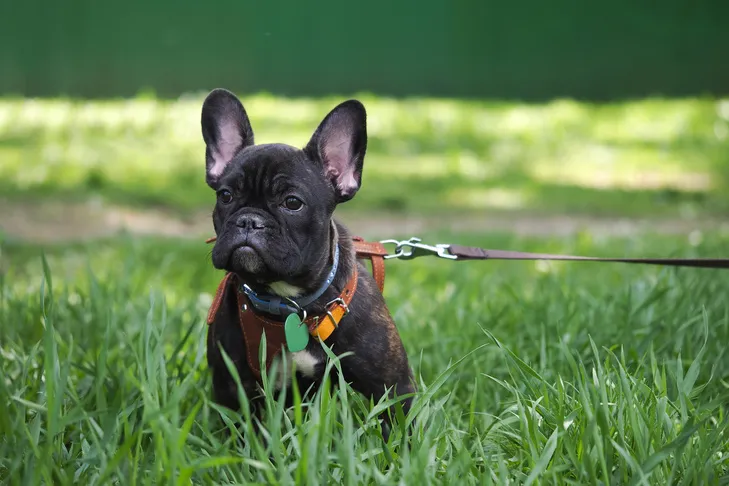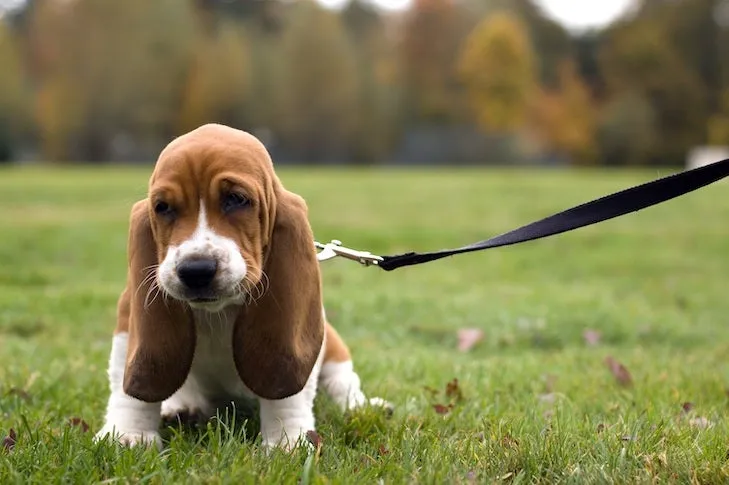Many new puppy owners assume that polite leash walking is an innate skill for dogs. However, this crucial ability, which you’ll appreciate on every outing, must be taught through consistent training and positive reinforcement. A well-behaved dog on a leash ensures a more enjoyable and safer experience for both you and your furry companion. This guide will walk you through the essential steps to successfully teach your puppy how to walk on a leash, ensuring they become a confident and well-mannered walking partner.
Laying the Foundation: Essential Puppy Leash Training Steps
Establishing a strong foundation is key to successful leash training. These initial steps focus on positive association and clear communication, setting your puppy up for success.
Introducing the Collar, Harness, and Leash
The very first step in Teaching Your Puppy How To Walk On A Leash is familiarizing them with their gear. Begin by introducing a lightweight collar or a comfortable harness and a leash. Allow your puppy to wear these items for brief periods inside the house, always supervising them. During this time, engage them in play and offer delicious treats. The goal is to create a positive association, making “collar and leash time” synonymous with fun and rewards. This early conditioning helps prevent your puppy from developing a negative perception of their walking equipment.
Teaching a Positive Reinforcement Cue
A clear communication cue is vital for effective training. Introduce a specific sound cue that signals “food is coming” to your puppy. Popular choices include a clicker, a verbal cue like “yes,” or even a tongue cluck. The method remains consistent: in a quiet, distraction-free environment with your puppy on their collar and leash, make your chosen sound. The instant your puppy turns towards or looks at you, immediately reward them with a treat. After several repetitions, your puppy will begin to anticipate the treat, not only looking at you but actively coming closer in expectation of the reward. This builds their focus on you, which is paramount for successful leash walking.
Encouraging Your Puppy to Follow
Once your puppy understands the “food is coming” cue, it’s time to encourage them to follow. While they are on their way to you, still wearing their leash and collar, take a few steps backward. Reward them enthusiastically when they reach you. Gradually, extend this progression. You’ll notice your puppy, upon hearing the cue, will come to you and walk a few paces alongside you. Remember that puppies have notoriously short attention spans. Keep your training sessions brief and always end on a positive note, when your puppy is still eager to continue, rather than mentally exhausted. This approach fosters a love for training and prevents burnout.
Practicing Leash Walking Indoors
With the foundational steps in place, it’s time to practice walking a few steps in a low-distraction indoor environment. Even in a familiar room, feeling and seeing the leash around them will be a significant new challenge for your puppy. Continue to offer treats and praise generously as your puppy learns to come to you and walk by your side with the leash on. This controlled setting allows them to focus on the mechanics of walking politely on a leash without the overwhelming stimuli of the outdoors.
Taking Leash Training Outdoors
Finally, your puppy is ready to test their newfound skills in the great outdoors. This step introduces a new level of complexity due to the myriad of sounds, smells, and sights that will naturally intrigue your puppy. Patience is crucial here, and initial outdoor walks should be kept very short. Maintain constant vigilance, keeping your eyes on your puppy at all times. If you observe your puppy about to lunge towards something or getting distracted, immediately use your cue sound and take a few steps away. Reward them with a treat for following you, reinforcing that staying with you is more rewarding than chasing distractions. teach dog not to pull on lead and staying focused on you is a key part of successful outdoor walks.
 French bulldog puppy in a harness sitting in tall green grass on a leash for a walk.
French bulldog puppy in a harness sitting in tall green grass on a leash for a walk.
Troubleshooting Common Leash Training Challenges
Even with solid foundational training, puppies and older dogs alike may encounter issues during leash walks, especially as they mature, visit new places, and face novel distractions. Learning to achieve loose-leash walking is beneficial for both of you, making walks much more pleasant and even enabling your dog to pass tests like the Canine Good Citizen. Here are some practical tips for addressing common leash training problems.
What to Do If Your Puppy Pulls
If your puppy begins to pull aggressively in the opposite direction, employ the “be a tree” technique. Stand completely still and refuse to move an inch until your dog returns to your side and the leash slackens. Avoid yanking, jerking the leash, or dragging your dog along. Consistency is vital with this method. For persistent pullers, alternative training tools such as front-hook harnesses or head halters can be highly effective in teaching them how to walk a puppy that pulls more politely. These tools redirect their pulling force more safely and efficiently. Remember, the goal is to teach them that pulling gets them nowhere, while a loose leash allows forward movement. how to train a puppy not to pull involves patience and consistent reinforcement of desired behavior.
Addressing Puppy Lunging
When your dog attempts to lunge at something during a walk—be it another dog, a car, or a skateboarder—proactivity is your best defense. The moment you anticipate a lunge, try to redirect their attention with a high-value treat before they have the chance to react. Increase the distance between your dog and the perceived target of their frustration. Stay alert and be prepared, creating space as soon as you spot a potential trigger. While this behavior might be more common in certain breeds, any dog can be startled or overstimulated. Teaching your dog to focus on you, even amidst distractions, is crucial to manage and prevent lunging.
 Basset Hound puppy sitting in the grass on lead.
Basset Hound puppy sitting in the grass on lead.
Managing Puppy Barking on Leash
Some dogs develop a habit of barking at other dogs or people while on walks. Often, this behavior can stem from a lack of sufficient physical and mental stimulation. Ensure your dog receives the appropriate amount of exercise and enrichment for their age and breed. If barking persists, apply a similar strategy to that used for lunging. Create distance from the trigger and offer treats before your dog starts to bark. With consistent practice, your dog will learn to associate seeing other dogs with receiving a treat, gradually turning their attention to you rather than barking. how to stop pitbull from pulling on leash is similar to addressing barking – it all comes down to consistent training and redirecting their focus. how to teach dog to stop pulling on leash also relies on these principles.
As your puppy progresses, you will gradually reduce the frequency of treats and the intensity of troubleshooting needed during walks. It’s always a good practice to keep a few treats on hand to randomly reinforce good leash-walking behavior, ensuring that positive habits are maintained and strengthened over time.
Consistent training, patience, and positive reinforcement are the cornerstones of teaching your puppy how to walk politely on a leash. By following these steps and addressing challenges proactively, you’ll foster a strong bond with your dog and enjoy many happy walks together. If you find yourself struggling, remember that seeking guidance from a professional dog trainer can provide tailored strategies and support.
